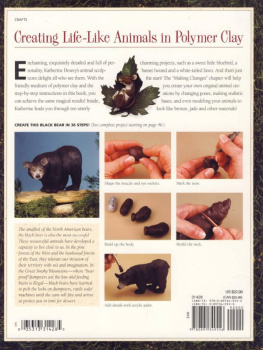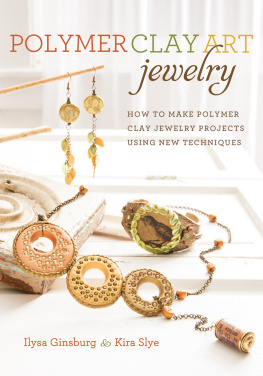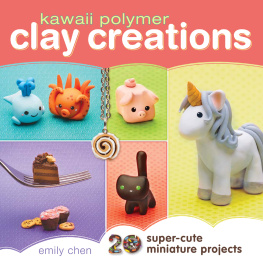Look, Learn & Create
Polymer Clay 101
A WORKSHOP IN A BOOK

Acknowledgments
Thanks to the online polymer clay community for the many things theyve taught me and for the many friends Ive made. Without them, there would be so much more error to my trial and error! Thanks to the Central Oklahoma Polymer Clay Guild for helping me stretch beyond my comfort zone. Thanks to Christi Friesen for her giving personality and for her role in making this book happen. I am grateful beyond words to my family for believing in me. And most of all, thanks to Billy for the adventures!
Angela
Id like to thank my husband, Jeff, for being the cameraman and being the best clay conditioning machine on the east coast. Also, Id like to thank Pamela Cole for helping me with the text.
Kim
Contents
Introduction
Like many artists, I had heard about polymer clay, but had a lot of other crafts in my life, and wasnt sure I had time for another one. Then I saw a very shiny, perfectly round bangle bracelet. When I looked closer, I saw tiny designs and intricate patterns throughout the bangle. The bracelet was beautiful. I thought, This is made out of polymer clay? Amazing!
Inspired by what I had seen, I bought just a few colors of clay. Within a day I realized I wanted more colors. At first, I was intrigued by the variety of colors and all the shapes I could make. I continued to buy clay in different colors, purchased a few more tools and supplies, and forgot about sleeping for the next few weeks. I started researching the work of different artists, reading books on polymer clay, and making lots of beads. Making beads led the way to making pendants and pins, then earrings, and finally to fashioning colorful handles for all my tools. Then I thought, Why not handles for serving pieces? Why not make magnets, knobs for drawers, key chains, and then actual chains made from the clay? I found polymer clay to be very simple to work with, and it was increasingly clear to me that if I had a design idea, I probably could do it with polymer clay. This adventure began ten years ago, and Im still excited about the creative possibilities of working with polymer clay.
If you are involved in crafts of any kind, you can apply the skills youve already learned to working with polymer clay. Polymer clay can be rolled, shaped, carved, painted, stamped, glued, layered, sanded, drilled, sewn, woven, crocheted, polished, even sent as a postcard. Can you begin to imagine how many different ways you might be able to use this amazing twentieth-century product to fulfill your creative ideas?
Over the last few years, I have been fortunate enough to meet and take classes with some of the best polymer artists in the country. In doing so, I have learned that there are as many techniques and ways of working with polymer clay as there are artists and craftspeople. Polymer clay does not have many rules, there are no rigid guidelines or absolutes, no right or wrong way. Its an amazing medium with incredible potential in everyones hands. Polymer clay is easy and fun and can go anywhere your imagination wants to go.
Kim
For me, polymer clay was love at first sight. I came across it more than ten years ago in a toy store, but I quickly realized that clay wasnt just for kids. In fact, I am constantly amazed by the beautiful works of art created by my fellow polymer clay artists.
My favorite thing about polymer clay is its versatility. It can be combined with so many different materials and used in so many ways that its impossible to become bored. If you can imagine something, you can create it with polymer clay.
Angela

How to Use This Book
Each project in this book is designed to teach you a new technique or basic skill. This concept is outlined under What Youll Learn. A list of What Youll Need is provided for each project, beginning with the clay colors and proportions for mixing them, followed by tools and other materials. Throughout the projects, refer to the Quick References at the side of the page for definitions or elaborations on words printed in italics. Use this book as a resource for the explanation of different techniques and as a jumping off point for inspiration.
History of Polymer Clay
Polymer clay has been in existence for over 70 years. It was developed in the 1930s in Germany by doll makers who wanted a strong, moldable clay for making doll heads and miniatures. The Fimo brand of polymer clay was further developed by Eberhard Faber who imported it to the United States in the 1970s. Cernit, another popular brand of clay, is made in Germany and imported to the United States.
Sculpey polymer clay was developed by Polyform Products Company for industrial use in the 1940s. However, it was not until the 1960s that the Sculpey clay was marketed as a sculptural medium for artists and craftspeople. In the mid-1980s, the Sculpey brand expanded the product line to a wide variety of different colors. In the 1990s, the Polyform Products Company developed the Premo! Sculpey brand of polymer clay, which had more elasticity and strength, making it popular with growing numbers of artists who wanted their clay to be more durable. Today, the Polyform Products Company has expanded the Sculpey line to include polymer clay for many different applications including Sculpey SuperFlex Bake & Bend, Sculpey Amazing Eraser Clay, Sculpey Ultralight, and Studio by Sculpey.
Kato Polyclay was developed in 2002 by Van Aken International and Donna Kato, a well-known polymer clay artist. Kato clay is designed to meet the needs of the serious polymer clay artist by providing strength, durability, and an excellent surface for polished finishes.
Composition
Polymer clay is manufactured by several different companies, each of which uses a slightly different formula. The difference in each companys formulas gives each clay unique properties both before and after curing. The only way to become familiar with the properties of each brand of clay is to experiment and learn about the differences. Polymer clay manufacturers change the ingredients and formula of a product periodically, either in response to changes in safety regulations or from a desire to enhance the features of the product. Some of these changes may affect how the product performs when you work with it and after it is cured. As you experiment, its a good idea to keep a record, documenting which clay or combination of clays you used and how it worked in your project.
Safety
Polymer clay is made up of polyvinyl chloride, dyes, fillers, and a plasticizer that keeps the clay soft until it is cured. Polyvinyl chloride, also known as PVC, is the same plastic that is used in white plastic plumbing pipes. The clay has no water in it so it wont dry out. It has an indefinite shelf life if stored correctly and at the right temperature.
Polymer clay has undergone several studies to determine its safety and is labeled nontoxic based on the results of these studies. (See note opposite.) It is not meant to be used for or around food. If using a conventional oven, precautions should be taken to keep the clay and fumes contained. Small children should be carefully supervised when playing with polymer clay.
Note: There still remains some controversy over the acceptable levels of exposure to phthalate plasticizers in polymer clay. Studies done by Duke University Health System and Arts and Crafts Materials Institute in Boston have deemed polymer clay safe and actual transfer rates to skin and food to be lower than expected. Certain toxic phthalates were restricted in 2009 in the United States and the European Union. Most manufacturers have already changed their formulas to meet the new standards for safety.
Next page









